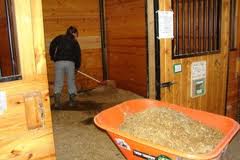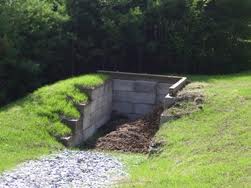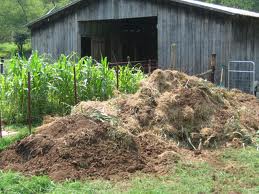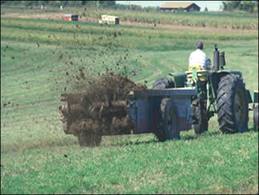|
Manure ManagementWith proper planning, manure management can be beneficial to both the farm and the environment. Many horses spend a significant portion of their day in stalls, accumulating large amounts of manure and stall waste. Additionally, horse facilities are often managed on relatively small acreage, limiting manure storage and application options. Please contact your local extension agent or natural resources conservation service field office for technical support.

Horse Manure Production and Characteristics
Horses produce large amounts of manure. On any given day, the average 1,000-pound horse will produce approximately 50 pounds of manure. Manure is not the only material being removed when stalls are cleaned. Wet and soiled bedding material must also be removed and can equal almost twice the volume of the manure itself. Total stall waste produced averages between 60 and 70 pounds per day, which amounts to approximately 12 tons of stall waste per year.
Many horse owners do not have enough land or vegetative cover to properly apply large amounts of manure and nutrients. If not managed properly, manure can deposit excess nutrients into the environment via surface runoff or as a leachate, or water contaminated with manure, from improper manure storage and land application. This can negatively impact water quality and subject landowners to investigation, and in some cases, legal action under an Agricultural Stewardship Act. For these reasons, horse operations are encouraged to use best manure management practices and develop a nutrient management plan.
Internal parasites, insects, rodents and odors can be manure related health concerns on horse farms. These issues can be minimized through carefully planned manure management. Internal parasites may be found in horse manure and can compromise the health and welfare of the horses stabled or grazing the land. Composting manure and properly timed land application can limit the risk of parasite exposure. Insects, especially flies, become a nuisance on farms where stockpiled manure serves as fly larvae habitat.
Naturally occurring fly predators can also be used to limit the fly population at the manure pile but are no replacement for sound manure management practices. Rodents can be a problem when manure is stockpiled for extended periods of time, providing them with a warm, safe environment. Additionally, nuisance odor from manure piles can result in strained relationships with neighbors. Composting or timely removal of manure piles will help keep odors to a minimum.
Horse Manure Storage and Utilization
The average horse produces between 60 and 70 pounds of stall waste per day. Multiply this by several horses, and it is easy to see the importance of having good manure managment. Letting manure pile up in stalls and paddock areas leads to a host of problems. It is not only unhealthy for your horse, inviting for pests and odors and aesthetically unpleasing, but the sheer amount of manure produced will overwhelm you. Many handling and storage options exist, but it's up to you to choose the method that best suits your horse operation.
In many situations, manure can be picked directly from the stall, deposited into a manure spreader, applied to the pasture and harrowed into the soil. Barns not constructed with a management scheme allowing for stall access by a manure spreader require manure to be carted from the stall to the manure spreader some distance away. In this case, ramps or dropped spreader parking can be helpful to avoid lifting the heavy, cumbersome stall waste. Keep in mind that when spreading manure from stalls bedded with sawdust or shavings, the applied stall waste can stunt plant growth.

When direct pasture application is not an option, manure storage facilities become a necessity. The storage facility should be convenient to the barn. A general rule of thumb is to plan for 180 days of long term manure storage. This allows operations the flexibility to store manure when conditions are not ideal for manure application, as when fields are frozen or wet. This storage area should be accessible to the equipment that will ultimately remove the accumulated stall waste. Manure storage facilities should also be downwind and screened from nearby homes to avoid potential complaints about odors and aesthetics. Always be sure to contact your local authorities regarding zoning regulations and additional restrictions for manure management.
Manure storage Ideally, storage piles should be placed on gravel, hardened clay or concrete pads that slope inward. The construction of manure storage sites will vary, based on individual situations and soil types. For instance, concrete pads may be necessary in areas with sandy soils where contaminants are more likely to reach groundwater. Storage piles should not be placed in low lying or flood prone areas, and care should be taken to direct water from higher elevations away from the site. The natural resources conservation service or local soil and water conservation district offices can provide individualized manure storage design specifications for manure managment.
With careful planning, proper manure management not only protects the environment and increases the efficiency and aesthetics of your farm, but might also save you money while enhancing your pastures.
Source - J. Davis, and C. Smith, manure management
Return from Manure Management to Horse Riding Connection
|
 Environmental and Health Impacts
Environmental and Health Impacts
 Horse operations with available land may choose to apply stall waste to pastures as fertilizer. This should be done based on soil-test results and nutrient needs. A soil analysis is needed to determine the fertility needs of a pasture. Soil analysis is provided through your land grant university's soil testing laboratory for agricultural operations, which include horse farms, free of charge. Contact your local cooperative extension office for instructions on how to take a soil sample. There are also private laboratories that offer soil testing services.
Horse operations with available land may choose to apply stall waste to pastures as fertilizer. This should be done based on soil-test results and nutrient needs. A soil analysis is needed to determine the fertility needs of a pasture. Soil analysis is provided through your land grant university's soil testing laboratory for agricultural operations, which include horse farms, free of charge. Contact your local cooperative extension office for instructions on how to take a soil sample. There are also private laboratories that offer soil testing services. 